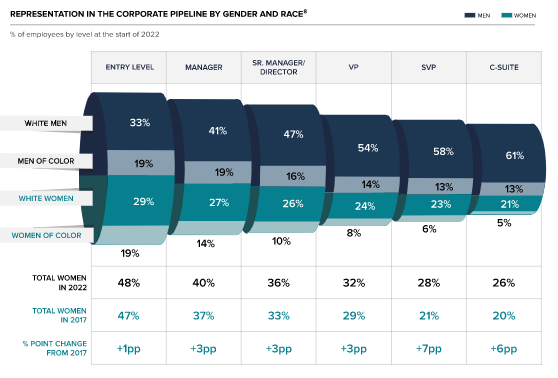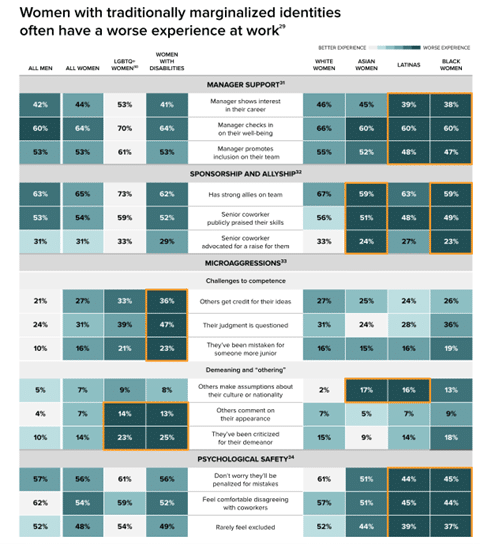As we close out Women’s History Month in March, I wanted to highlight The 2022 Women in the Workplace Report. As the largest study of its kind with 40,000 participants, this report is packed with useful information and resources that can help you create a more actionable roadmap.
I have highlighted key points and takeaways you can use within your organization. As you read them, think about how you perceive them. What is the most surprising thing about this data? Does it jive with what’s going on in your own organization?
One in, Two out: Women are Leaving Leadership in Droves
Women leaders are leaving companies for three key reasons:
1. Women leaders want to advance, but they face stronger headwinds than men. Women are equally eager to receive promotions and likely to strive for higher-paid positions as men. However, in many of their work environments, women face microaggressions. These behaviors communicate to them that they are not truly respected for the authority they possess, nor will it be as easy for them to obtain that coveted promotion as their male coworkers.
2. Women leaders are overworked and under-recognized. Compared to the men at their level, women leaders tend to do more in DEI (diversity, equity, and inclusion) and support their employees’ well-being. This kind of contribution to their workplace is crucial to improving retention and employee satisfaction. Unfortunately, attention to DEI is not formally seen as such and is seldom rewarded in most companies. Women leaders spend their time working on improving their office culture along with their everyday workload. Because of this, they are far more likely to become burned out compared to men holding positions of a similar level.
3. Women leaders want a better work culture. Tying in the last point about DEI, women often leave their high-ranking positions in favor of a company with better flexibility and more focus on DEI and employee satisfaction.
“If no action is taken to remedy these relevant issues, women leaders will continue to leave their positions, and hiring other women, especially younger women, will become more difficult.”
NOW – Preventing Attrition: What can you do in the context of talent optimization to combat these reasons?
FUTURE – Safeguard Pipeline: The factors driving women leaders to switch jobs are even more important to young women. In considering your leadership pipeline, what cultural shifts need to take place in order to meet your goals?
Women, especially women of color, miss out on promotions early.
The hardest step for a woman leader to make is the one from individual contributor to manager. For every one hundred men promoted to manager, only 87 women and 82 women of color are promoted.
If your organization has inclusion goals that involve bringing more women into leadership roles, how can you address this ‘broken rung”?
Managers aren’t trained to minimize burnout
Most managers receive zero instruction on how to minimize burnout on their team. Even fewer receive training related to fairness, equity, or diversity. Women are more likely to suffer from burnout while trying to remedy these issues in DEI themselves.
Can you identify opportunities in your organization where you can provide additional training and support to recognize and minimize burnout?
Women with traditionally marginalized identities often have a worse experience at work
Below are a few highlights, but the graph is most effective at conveying the experience women have at work. Many leaders reject the idea that their organization is biased or discriminates because they can point to the few people at the top from traditionally marginalized groups. We’ve even seen women leaders say, “I made it, they should have been able to as well.” Know that those are the exceptions and not the rule.
- Women of color are more ambitious despite getting less support.
- Latinas and Black women are less likely than women of other races and ethnicities to say their manager shows interest in their career development.
- Asian women and Black women are less likely to have strong allies on their teams.
- Women with disabilities often have their competence challenged and undermined.
- LGBTQ+ women and women with disabilities are more likely to experience demeaning and “othering” microaggressions.
After seeing the current working conditions of women in the workplace nationwide, how does this information translate to your business? Do you conduct an employee experience survey? What does the data tell you? What will you do in 2023 to build a better business environment for the leading women in your business?




